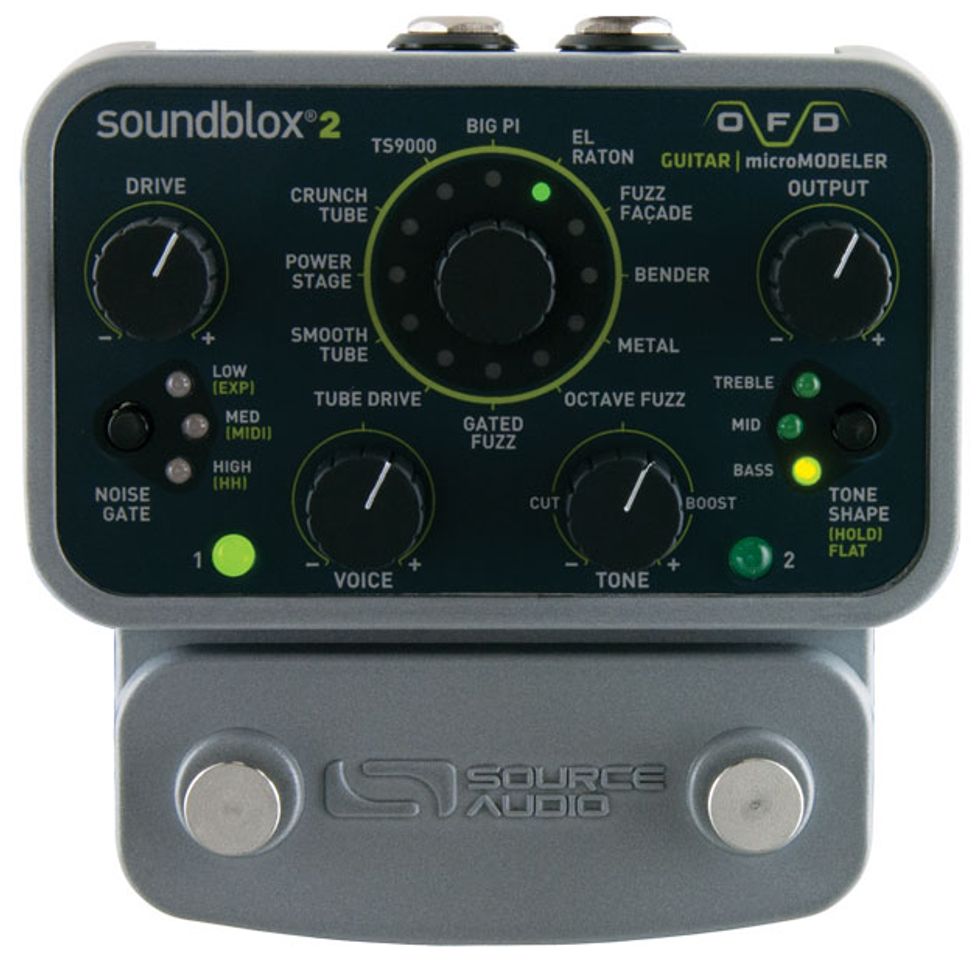The pedals in Source Audio’s Soundblox 2 series must be contenders for the function-to-size ratio championship. The new Soundblox OFD (Overdrive Fuzz Distortion), for example, assembles a variety of vintage- and boutique-flavored gain circuits into a single ultra-versatile dirt machine. The OFD also lets you store your presets and edit your tones in a manner few pedals of this size allow.
Dual-Footswitch DelightThe heart this impressive tweakability is the center knob, used to access the distortion/amp/fuzz bank. There are 12 overdrive, fuzz, and distortion types to choose from, including a Fuzz Face model (“Fuzz Façade”), a Marshall Plexi (“Tube Drive”), and a Mesa Boogie (“Smooth Tube”).
Once you’ve selected an effect, you can adjust its properties via the drive, tone, and voice knobs. The tone knob works with the tone shape button, which lets you tweak treble, mid, and bass frequencies. You can apply a threshold-variable gate to any of the basic sounds. The voice knob is essentially a brilliance/presence control, helpful for adding a little extra sheen and definition.
The dual-footswitch design allows you to store settings to two presets, which you save by holding down the selected switch for a few seconds. There’s also a multi-function in/out for connecting MIDI, an expression pedal, or Source Audio’s own Hot Hand controller. The OFD arrives set to its true-bypass mode, but you can switch to a relay-based buffer by powering up the pedal with the right footswitch depressed.
A functional, navigable layout is critical to the success a multi-effector—all those options don’t amount to much if they’re impossible to decipher and use! The OFD works well in this regard, save for a few minor exceptions.
Because the entire effects bank shares a single control set, making adjustments on the fly can be tricky. For example, if you turn on Preset 1, the OFD activates the effect as you’ve previously stored it. However, if you tweak the drive or output knobs even slightly, the OFD must make a potentially jerky adjustment to compensate for the difference between the new knob setting and the stored sound. This becomes an issue if you accidentally hit either knob while playing, as I discovered by bumping the drive knob, which had been left at a high setting, while using a preset saved with a low-gain setting. Result: a dramatic and unwanted burst of gain. Thankfully, the pedal’s two-tier design helps keep your toes away from the knobs on the upper tier. Still, you must be careful on dark stages and in the heat of performance.
While some of the effects are fine out of the box, you’ll probably want to take advantage of the tone shape control. With the TS9000 overdrive engaged, for instance, my single-coil guitars delivered a straightforward bite suited for most blues and rock. The hot humbuckers in a DeArmond M-75T, however, needed a bit of help from the tone shape control to avoid the midrange spike typical of TS-9-style effects. Boosting treble and axing some mids, I crafted a well-rounded, rich overdrive with an authoritative blues-rock bellow (especially through a clean Fender amp).
Ratings
Pros:
Good quality and quantity of amp/fuzz models.
Cons:
Changing preset parameters mid-performance can be frustrating. Can’t engage both effects at once.
Tones:
Ease of Use:
Build/Design:
Value:
Street:
$169
Source Audio OFD
sourceaudio.net
The noise gate effectively tames the white noise that can accompany cranked high-gain settings. I found the medium setting to be the most effective—the low setting seems inconsistent for quieter, cleaner settings, and the high setting can clip sustained tones if you’re not careful.
Solid Simulations
Most settings capture the essence of the effects they emulate. That said, you shouldn’t engage “Crunch Tube” and expect the sound of a true Marshal Plexi. Clearly, Source Audio put a lot of time into crafting these models. Like a Fuzz Face, “Fuzz Façade” is extremely responsive to changes in guitar volume, making it great for veering from rhythm to lead using just your volume knob. Similarly, the “Octave Fuzz” tones become more defined when you roll back your guitar’s volume—great for copping Hendrix-style dynamics. Wrangling the “Big Pi” is a breeze with the tone shape parameters. It can supply nasal highs and heavy bottom-end fuzz, depending on how you set the EQ.
The Verdict
The OFD offers a great variety of crunch and gain tones in a tidy little package—an impressively expansive sound spectrum for the $169 price. There are some tradeoffs, though, especially the fact that mid-performance adjustments can be tricky. Also, while the ability to save two different distortion types in a single pedal is a big plus, you can’t engage both at once—no cascading that virtual Tone Bender into the Fuzz Face simulation, for example. But if you want to cover as much overdrive/distortion territory as possible with a super-compact package, the Soundblox 2 OFD is a great place to start your quest.








![Rig Rundown: Russian Circles’ Mike Sullivan [2025]](https://www.premierguitar.com/media-library/youtube.jpg?id=62303631&width=1245&height=700&quality=70&coordinates=0%2C0%2C0%2C0)

















